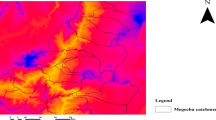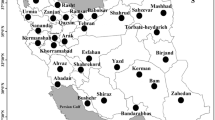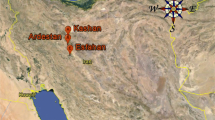Abstract
An accurate estimation of reference evapotranspiration (ET0) is of paramount importance for many studies such as hydrologic water balance, irrigation system design and management, crop yield simulation, and water resources planning and management. Simple regression techniques, may sometimes, provide adequate estimation of ET0. Implementation of regression methods considering all the predictor variables may, however, lead to overfit and consequent reduction in the predictive capability. The regression models for ET0 have been developed in the present study for Tirupati, Nellore, Rajahmundry, Anakapalli and Rajendranagar regions of Andhra Pradesh, India by following step-wise procedure, eliminating superfluous predictor variables based on statistical criteria. The sunshine hours, wind velocity, temperature and relative humidity influenced ET0 in the study area. The linear regression models developed in terms of predictor variables may conveniently be applied in the regions selected for the present study and, in the regions with similar climatic conditions for satisfactory ET0 estimation.



Similar content being viewed by others
References
Alkaeed O, Flores C, Jinno K, Tsutsumi A (2006) Comparison of several reference evapotranspiration methods for Itoshima Peninsula area, Fukuoka, Japan. Mem Fac Eng Kyushu Univ 66(1):1–14
Allen RG, Pereira LS, Raes D, Smith M (1998) Crop evapotranspiration guidelines for computing crop water requirements. FAO Irrigation and Drainage Paper No. 56, FAO. Rome
Amatya DM, Skaggs RW, Geregory JD (1995) Comparison of methods for estimating REF-ET. J Irrig Drain Eng 121(6):427–435
Berengena J, Gavilan P (2005) Reference evapotranspiration estimation in a highly advective semiarid environment. J Irrig Drain Eng 131(2):147–163
Chen F, Robinson PJ (2009) Estimating reference crop evapotranspiration with ET gages. J Irrig Drain Eng 135(3):335–342
Denmirtas C, Buyukcangaz H, Yazgan S, Candogan BN (2007) Evaluation of evapotranspiration estimation methods for sweet Cherry trees (Prunus avium) in sub-humid climate. Pak J Biol Sci 10(3):462–469
Frevert DK, Hill RW, Braaten BC (1983) Estimation of evapotranspiration coefficients. J Irrig Drain Eng 109(2):265–270
Gavilan P, Estevez J, Berengena J (2008) Comparison of standardized reference evapotranspiration equations in Southern Spain. J Irrig Drain Eng 134(1):1–12
Hao A, Marui A, Haraguchi T, Nakano Y (2006) Comparison of evapotranspiration measured by lysimeter and calculated by various estimating methods. J Fac Agric Kyushu Univ (Jpn) 51(2):417–421
Hussein ASA (1999) Grass ET estimates using Penman type equations in central Sudan. J Irrig Drain Eng 125(6):324–329
Igbadun H, Mahoo H, Tarimo A, Salim B (2006) Performance of two temperature-based reference evapotranspiration models in the Mkoji sub-catchment in Tanzania. Agricultural Engineering International: the CIGR Ejournal. Manuscript LW 05 008. Vol.VIII
Irmak S, Haman DZ, Jones JW (2002) Evaluation of class A pan coefficients for estimating reference evapotranspiration in humid location. J Irrig Drain Eng 128(3):153–159
Irmak S, Irmak A, Allen RG, Jones JW (2003) Solar and net radiation-based equations to estimate reference evapotranspiration in humid climates. J Irrig Drain Eng 129(5):336–347
Itenfisu D, Elliott RL, Allen RG, Walter IA (2003) Comparison of reference evapotranspiration calculations as part of the ASCE standardization effort. J Irrig Drain Eng 129(6):440–448
Jabulani J (2008) Evaluation of the potential of using the modified Jensen – Haise model as an irrigation scheduling technique in Zimbabwe. EJEAFChe 7(14):2771–2778
Kashyap PS, Panda RK (2001) Evaluation of evapotranspiration estimation methods and development of crop coefficients for Potato crop in a sub-humid region. Elsevier, Agric Water Manag 50:9-25
Katerji N, Rana G (2010) Crop reference evapotranspiration: a discussion of the concept, analysis of the process and validation. Water Resour Manage 25:1581–1600
Liang GC, Connor O, Kachroo RK (1994) A multiple-input single-output variable gain model. J Hydrol 155:185–198
Nandagiri L, Kovoor MG (2006) Performance evaluation of reference evapotranspiration equations across range of Indian climates. J Irrig Drain Eng 132(3):238–249
Nash JE, Sutcliffe JV (1970) River flow forecasting through conceptual models-I: a discussion of principles. J Hydrol 10(3):238–250
Perugu M, Singam AJ (2008) Evapotranspiration studies for irrigation projects-a case study. J Inst Eng (India) Agric Eng Div 89:5–13
Sabziparvar AA, Tabari H, Aeini A, Ghafouri M (2010) Evaluation of class A pan coefficient models for estimation of reference crop evapotranspiration in cold semi-arid and warm climates. Water Resour Manage 24:909–920
Shah SB, Edling RJ (2000) Daily evapotranspiration prediction from Louisiana flooded rice field. J Irrig Drain Eng 126(1):8–13
Snyder RL (1992) Equation for evaporation pan to evapotranspiration conversions. J Irrig Drain Eng 118:977–980
Suleiman AA, Hoogenboom G (2007) Comparison of Priestley-Taylor and FAO-56 Penman-Monteith for daily reference evapotranspiration estimation in Georgia. J Irrig Drain Eng 133(2):175–182
Sumner DM, Jacobs JM (2005) Utility of Penman–Monteith, Priestley–Taylor, reference evapotranspiration, and pan evaporation methods to estimate pasture evapotranspiration. J Hydrol 308:81–103
Temesgen B, Eching S, Davidoff B, Frame K (2005) Comparison of some reference evapotranspiration equations for California. J Irrig Drain Eng 131(1):73–84
Trajkovic S, Stojnic V (2008) Simple daily ET0 estimation techniques. Facta Universitatis. Ser Architect Civ Eng 6(2):187–192
Vangelis H, Tigkas D, Tsakiris G (2012) The effect of PET method on Reconnaissance Drought Index (RDI) calculation. J Arid Environ 88:130–140
Vudhivanich V (1996) Monthly potential evapotranspiration of Thailand. Kasetsart J (Nat Sci) 30:392–399
Xing Z, Chow L, Meng FR, Rees HW, Montieth J, Lionel S (2008) Testing reference evapotranspiration estimation methods using evaporation pan and modeling in maritime region of Canada. J Irrig Drain Eng 134(4):417–424
Xu CY, Singh VP (2002) Cross comparison of empirical equations for calculating potential evapotranspiration with data from Switzerland. Water Resour Manage 16:197–219
Ye J, Guo A, Sun G (2009) Statistical analysis of reference evapotranspiration on the Tibetan plateau. J Irrig Drain Eng 135(2):134–140
Yu PS, Liu CL, Lee TY (1994) Application of transfer function model to a storage runoff process. Stochast Stat Methods Hydrol Environ Eng 3:87–97
Yuan W, Liu S, Liang S, Tan Z, Liu H, Ypung C (2012) Estimations of evapotranspiration and water balance with uncertainity over the Yukon river basin. Water Resour Manage 26:2147–2157
Author information
Authors and Affiliations
Corresponding author
Rights and permissions
About this article
Cite this article
Perugu, M., Singam, A.J. & Kamasani, C.S.R. Multiple Linear Correlation Analysis of Daily Reference Evapotranspiration. Water Resour Manage 27, 1489–1500 (2013). https://doi.org/10.1007/s11269-012-0250-7
Received:
Accepted:
Published:
Issue Date:
DOI: https://doi.org/10.1007/s11269-012-0250-7




